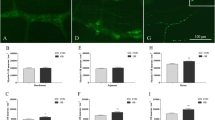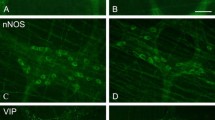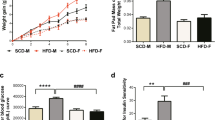Abstract
Symptoms of diabetic gastrointestinal dysmotility indicate neuropathy of the enteric nervous system. Long-standing diabetic enteric neuropathy has not been fully characterized, however. We used prolonged high fat diet ingestion (20 weeks) in a mouse model to mimic human obese and type 2 diabetic conditions, and analyzed changes seen in neurons of the duodenal myenteric plexus. Ganglionic and neuronal size, number of neurons per ganglionic area, density indices of neuronal phenotypes (immunoreactive nerve cell bodies and varicosities per ganglion or tissue area) and nerve injury were measured. Findings were compared with results previously seen in mice fed the same diet for 8 weeks. Compared to mice fed standard chow, those on a prolonged high fat diet had smaller ganglionic and cell soma areas. Myenteric VIP- and ChAT-immunoreactive density indices were also reduced. Myenteric nerve fibers were markedly swollen and cytoskeletal protein networks were disrupted. The number of nNOS nerve cell bodies per ganglia was increased, contrary to the reduction previously seen after 8 weeks, but the density index of nNOS varicosities was reduced. Mice fed high fat and standard chow diets experienced an age-related reduction in total neurons, with bias towards neurons of sensory phenotype. Meanwhile, ageing was associated with an increase in excitatory neuronal markers. Collectively, these results support a notion that nerve damage underlies diabetic symptoms of dysmotility, and reveals adaptive ENS responses to the prolonged ingestion of a high fat diet. This highlights a need to mechanistically study long-term diet-induced nerve damage and age-related impacts on the ENS.







Similar content being viewed by others
References
Amos AF, McCarty DJ, Zimmet P (1997) The rising global burden of diabetes and its complications: estimates and projections to the year 2010. Diabet Med 14(Suppl 5):S1–S85
Anitha M, Gondha C, Sutliff R et al (2006) GDNF rescues hyperglycemia induced diabetic enteric neuropathy through activation of the PI3K/Akt pathway. J Clin Invest 116:344–356
Azan G, Low WC, Wendelschafer-Crabb G et al (2011) Evidence for neural progenitor cells in the human adult enteric nervous system. Cell Tissue Res 344:217–225
Bagyánszki M, Bódi N (2012) Diabetes-related alterations in the enteric nervous system and its microenvironment. World J Diabetes 3:80–93
Baudry C, Reichardt F, Marchix J et al (2012) Diet-induced obesity has neuroprotective effects in murine gastric enteric nervous system: involvement of leptin and glial cell line-derived neurotrophic factor. J Physiol 590:533–544
Brock C, Søfteland E, Gunterberg V et al (2013) Diabetic autonomic neuropathy affects symptom generation and brain-gut axis. Diabetes Care 36:3698–3705
Byrtzer P, Talley J, Leemon M et al (2001) Prevalence of Gastrointestinal Symptoms Associated With Diabetes Mellitus. Arch Intern Med 161:189–1996
Camilleri M, Malagelada JR (1984) Abnormal intestinal motility in diabetics with the gastroparesis syndrome. Eur J Clin Invest 14:420–427
Cellek S, Qu W, Schmidt AM, Moncada S (2004) Synergistic action of advanced glycation and products and endogenous nitric oxide leads to neuronal apoptosis in vitro: A new insight into selective nitrergic neuropathy in diabetes. Diabetologia 47:331–339
Chandrasekharan B, Anitha M, Blatt R et al (2011) Colonic motor dysfunction in human diabetes is associated with enteric neuronal loss and increased oxidative stress. Neurogastroenterol Motil 23(131–138):e26
El-Salhy M, Sandström O, Holmlund F (1999) Age-induced changes in the enteric nervous system in the mouse. Mech Ageing Dev 107:93–103
Faussone-Pellegrini M, Grover M, Pasricha P et al (2012) Ultrastructural differences between diabetic and idiopathic gastroparesis. J Cell Mol Med 16:1573–1581
Fox J, Barthold S, Davisson M (2006) The Mouse in Biomedical Research: Normative Biology, Husbandry, and Models. Academic, New York
Furlan M, de Miranda NM, Sant’ana Dde M, Molinari S (1999) Number and size of myenteric neurons of the duodenum of adult rats with acute diabetes. Arq Neuropsiquiatr 57:740–745
Furness JB (2008) The enteric nervous system: Normal functions and enteric neuropathies. Neurogastroenterol Motil 20:32–38
Furness JB (2010) Enteric Nervous System. Blackwell, Oxford
Giaroni C, De Ponti F, Cosentino M et al (1999) Plasticity in the enteric nervous system. Gastroenterology 117:1438–1458
Gomes OA, de Souza RR, Liberti EA (1997) A preliminary investigation of the effects of aging on the nerve cell number in the myenteric ganglia of the human colon. Gerontology 43:210–217
Jack M, Wright D (2012) Role of advanced glycation endproducts and glyoxalase I in diabetic peripheral sensory neuropathy. Transl Res 159:355–365
Karaosmanoglu T, Aygun B, Wade P, Gershon M (1996) Regional differences in the number of neurons in the myenteric plexus of the guinea pig small intestine and colon: an evaluation of markers used to count neurons. Anat Rec 244:470–480
Knowles CH, De Giorgio R, Kapur RP et al (2009) Gastrointestinal neuromuscular pathology: guidelines for histological techniques and reporting on behalf of the Gastro 2009 International Working Group. Acta Neuropathol 118:271–301
Kunze WA, Furness JB (1999) The enteric nervous system and regulation of intestinal motility. Annu Rev Physiol 61:117–142
Laranjeira C, Sandgren K, Kessaris N et al (2011) Glial cells in the mouse enteric nervous system can undergo neurogenesis in response to injury. J Clin Invest 121:3412–3424
LePard KJ (2005) Choline acetyltransferase and inducible nitric oxide synthase are increased in myenteric plexus of diabetic guinea pig. Auton Neurosci 118:12–24
Lopes GS, Smaili SS, Neto AC et al (2007) Aging-induced decrease of cholinergic response and calcium sensitivity on rat jejunum contractions. J Gerontol A 62:264–270
Nezami B, Mwangi S, Lee J et al (2014) MicroRNA 375 mediates palmitate657 induced enteric neuronal damage and high-fat diet-induced delayed intestinal transit in mice. Gastroenterology 146:473–83.e3
Papanas N, Ziegler D (2012) Prediabetic Neuropathy: Does It Exist? Curr Diab Rep 12:376–383
Pasricha PJ, Pehlivanov ND, Gomez G et al (2008) Changes in the gastric enteric nervous system and muscle: A case report on two patients with diabetic gastroparesis. BMC Gastroenterol 8:21
Phillips RJ, Powley TL (2007) Innervation of the gastrointestinal tract: Patterns of aging. Auton Neurosci Basic Clin 136:1–19
Phillips RJ, Kieffer EJ, Powley TL (2004) Loss of glia and neurons in the myenteric plexus of the aged Fischer 344 rat. Anat Embryol (Berl) 209:19–30
Qu ZD, Thacker M, Castelucci P et al (2008) Immunohistochemical analysis of neuron types in the mouse small intestine. Cell Tissue Res 334:147–161
Rivera LR, Leung C, Pustovit RV et al (2014) Damage to enteric neurons occurs in mice that develop fatty liver disease but not diabetes in response to a high-fat diet. Neurogastroenterol Motil 26:1188–1199
Sang Q, Young HM (1996) Chemical coding of neurons in the myenteric plexus and external muscle of the small and large intestine of the mouse. Cell Tissue Res 284:39–53
Sang Q, Young HM (1998) The identification and chemical coding of cholinergic neurons in the small and large intestine of the mouse. Anat Rec 251:185–199
Sang Q, Williamson S, Young HM (1997) Projections of chemically identified myenteric neurons of the small and large intestine of the mouse. J Anat 190(Pt 2):209–222
Savidge TC (2011) S-nitrosothiol signals in the enteric nervous system: lessons learnt from big brother. Front Neurosci 5:31
Schmidt H, Riemann JF, Schmid A, Sailer D (1984) Ultrastructure of diabetic autonomic neuropathy of the gastrointestinal tract. Klin Wochenschr 62:399–405
Shotton HR, Lincoln J (2006) Diabetes only affects nitric oxide synthase containing myenteric neurons that do not contain heme oxygenase 2. Brain Res 1068:248–256
Smyth S, Heron A (2006) Diabetes and obesity: the twin epidemics. Nat Med 12:75–80
Spangeus A, El-Salhy M (2001) Myenteric plexus of obese diabetic mice (an animal model of human type 2 diabetes). Histol Histopathol 16:159–165
Spangeus A, Suhr O, El-Salhy M (2000) Diabetic state affects the innnervation of gut in an animal model of human type 1 diabetes. Histol Histopathol 15:739–744
Stenkamp-Strahm CM, Kappmeyer AJ, Schmalz JT et al (2013a) High-fat diet ingestion correlates with neuropathy in the duodenum myenteric plexus of obese mice with symptoms of type 2 diabetes. Cell Tissue Res 354:381–394
Stenkamp-Strahm C, Patterson S, Boren J et al (2013b) High-fat diet and age dependent effects on enteric glial cell populations of mouse small intestine. Auton Neurosci 177:199–210
Surendran S, Kondapaka SB (2005) Altered expression of neuronal nitric oxide synthase in the duodenum longitudinal muscle-myenteric plexus of obesity induced diabetes mouse: implications on enteric neurodegeneration. Biochem Biophys Res Commun 338:919–922
Tan LL, Bornstein JC, Anderson CR (2010) The neurochemistry and innervation patterns of extrinsic sensory and sympathetic nerves in the myenteric plexus of the C57Bl6 mouse jejunum. Neuroscience 166:564–579
Thrasivoulou C, Soubeyre V, Ridha H et al (2006) Reactive oxygen species, dietary restriction and neurotrophic factors in age-related loss of myenteric neurons. Aging Cell 5:247–257
Voss U, Sand E, Olde B, Ekblad E (2013) Enteric neuropathy can be induced by high fat diet in vivo and palmitic acid exposure in vitro. PLoS ONE 8:e81413
Voss U, Turesson MF, Robaye B et al (2014) The enteric nervous system of P2Y13 receptor null mice is resistant against high-fat-diet- and palmitic-acid induced neuronal loss. Purinergic Signal. doi:10.1007/s11302-014-9408-5
Voukali E, Shotton HR, Lincoln J (2011) Selective responses of myenteric neurons to oxidative stress and diabetic stimuli. Neurogastroenterol Motil 23:964–e411
Wade PR (2002) Aging and neural control of the GI tract. I. Age-related changes in the enteric nervous system. Am J Physiol Gastrointest Liver Physiol 283:G489–G495
Wang X, Pitchumoni CS, Chandrarana K, Shah N (2008) Increased prevalence of symptoms of gastroesophageal reflux diseases in type 2 diabetics with neuropathy. World J Gastroenterol 14:709–712
Yarandi SS, Srinivasan S (2014) Diabetic gastrointestinal motility disorders and the role of enteric nervous system: current status and future directions. Neurogastroenterol Motil 26:611–624
Acknowledgments
This study was funded by the University of Idaho, IBEST and Idaho INBRE (NIH Grant Nos. P20 RR016454 and P20 GM103408). Work done by M. Gericke was supported by Deutsche Forschungsgemeinschaft grant number DFG-SFB 1052/1: ‘Obesity mechanisms’ (projects A04). The authors would like to acknowledge Joe T. Schmaltz, Rachel Siemens, Sky Hembree and Spencer Dean for their assistance with staining and quantification procedures.
Author information
Authors and Affiliations
Corresponding author
Electronic supplementary material
Below is the link to the electronic supplementary material.
ESM 1
(DOCX 88.1 kb)
Rights and permissions
About this article
Cite this article
Stenkamp-Strahm, C.M., Nyavor, Y.E.A., Kappmeyer, A.J. et al. Prolonged high fat diet ingestion, obesity, and type 2 diabetes symptoms correlate with phenotypic plasticity in myenteric neurons and nerve damage in the mouse duodenum. Cell Tissue Res 361, 411–426 (2015). https://doi.org/10.1007/s00441-015-2132-9
Received:
Accepted:
Published:
Issue Date:
DOI: https://doi.org/10.1007/s00441-015-2132-9




